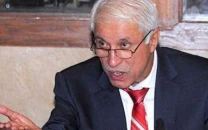3G or 4G: With new policy directive, uncertainty about technology removed
Operator will have a choice to bring third or fourth generation technology.

Next-generation mobile services offer a wide range of data services, such as text-based mobile applications, video calling and live streaming at enormous pace, thanks to the high data transfer rates these services offer.
With the federal government unable to roll out third-generation (3G) mobile services for years, cellular subscribers in Pakistan had been wondering as to why the government was hell-bent on introducing over a decade-old technology when the world was moving towards more advanced services – 4G and Long Term Evolution (LTE), for example.
The uncertainty is finally over. Pakistan, as per revised policy directive issued by the Ministry of IT and Telecommunication, has decided to allocate 30 megahertz (MHz) paired spectrum in the 1900-2100 MHz band for next-generation mobile networks. The spectrum will be technology neutral.
Technology neutral means that the operators can deploy the best technology now and can have the most modern technology afterwards, according to experts.
Next-generation mobile services offer high-speed mobile (portable) broadband connectivity to cellular consumers. In other words, the subscribers can take a wide range of data services, such as text-based mobile applications, video calling and live streaming at enormous pace, thanks to the high data transfer rates these services offer.
It is because of the high-speed mobile internet that data usage is increasing faster than voice in countries where 3G and 4G services are already in place.

The spectrum auction is considered to be the most preferred method to proliferate next-generation mobile technology.
By auctioning a spectrum, governments sell rights (licences) to telecommunication companies for transmitting signals over specific bands – 1900-2100 megahertz in the current case – of electromagnetic spectrum.
In other words, the spectrum auction means privatisation of public airways and a way for the government to allocate scarce resources of frequency spectrum and earn revenues in the process. The companies acquiring the rights get return on their investment by selling services to cellular subscribers while the latter benefits from the proliferation of technology by accessing services, such as e-education, e-governance, e-health to name a few.
While putting the spectrum for auction, the seller – the government in this case – sets a base or reserve price. The base price allows the seller to set a low starting price to generate interest and start bidding, and protects him from having to sell the spectrum at a very low price.
However, the government, in the current case, will determine the base price for the spectrum based on recommendations of consultants, who will be appointed in a couple of months. The consultants will also decide the number and size of the blocks in the proposed 30MHz spectrum.
As per the new policy directive, dated October 7, the allocation will be technology neutral and usable for technologies standardised for 3G and advanced-generation services. The auction is expected to be completed by March 2014 while the licence will be issued for 15 years.
“It is a good decision by the government to make it [spectrum auction] technology neutral,” said Parvez Iftikhar, former CEO of Universal Services Fund who also works as an information and communication technology consultant in various countries. “This will be up to the operator whether he wants to launch 3G or 4G,” he said.
Iftikhar, however, stated that 1900-2100 MHz band, the one to be auctioned, is most famous for 3G services – an indication that the country will initially receive 3G technology. The expert suggested that the next step should be to reform and put on auction 900-1800 MHz band – a famous band for 4G services.
Published in The Express Tribune, October 14th, 2013.
Like Business on Facebook, follow @TribuneBiz on Twitter to stay informed and join in the conversation.



















COMMENTS
Comments are moderated and generally will be posted if they are on-topic and not abusive.
For more information, please see our Comments FAQ